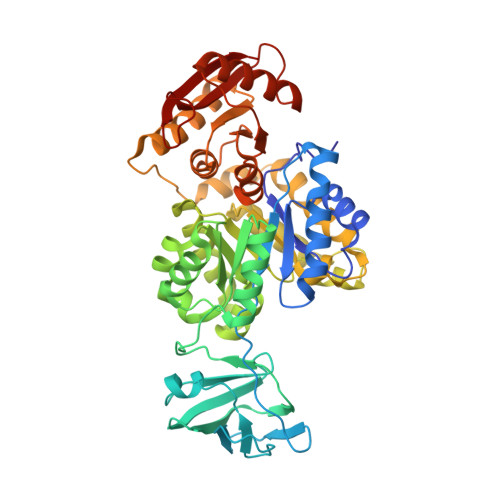The 2.4 angstrom structure of Zymomonas mobilis pyruvate kinase: Implications for stability and regulation.
Meneely, K.M., McFarlane, J.S., Wright, C.L., Vela, K., Swint-Kruse, L., Fenton, A.W., Lamb, A.L.(2023) Arch Biochem Biophys 744: 109679-109679
- PubMed: 37393983
- DOI: https://doi.org/10.1016/j.abb.2023.109679
- Primary Citation of Related Structures:
7UEH - PubMed Abstract:
Human liver pyruvate kinase (hlPYK) catalyzes the final step in glycolysis, the formation of pyruvate (PYR) and ATP from phosphoenolpyruvate (PEP) and ADP. Fructose 1,6-bisphosphate (FBP), a pathway intermediate of glycolysis, serves as an allosteric activator of hlPYK. Zymomonas mobilis pyruvate kinase (ZmPYK) performs the final step of the Entner-Doudoroff pathway, which is similar to glycolysis in that energy is harvested from glucose and pyruvate is generated. The Entner-Doudoroff pathway does not have FBP as a pathway intermediate, and ZmPYK is not allosterically activated. In this work, we solved the 2.4 Å X-ray crystallographic structure of ZmPYK. The protein is dimeric in solution as determined by gel filtration chromatography, but crystallizes as a tetramer. The buried surface area of the ZmPYK tetramerization interface is significantly smaller than that of hlPYK, and yet tetramerization using the standard interfaces from higher organisms provides an accessible low energy crystallization pathway. Interestingly, the ZmPYK structure showed a phosphate ion in the analogous location to the 6-phosphate binding site of FBP in hlPYK. Circular Dichroism (CD) was used to measure melting temperatures of hlPYK and ZmPYK in the absence and presence of substrates and effectors. The only significant difference was an additional phase of small amplitude for the ZmPYK melting curves. We conclude that the phosphate ion plays neither a structural or allosteric role in ZmPYK under the conditions tested. We hypothesize that ZmPYK does not have sufficient protein stability for activity to be tuned by allosteric effectors as described for rheostat positions in the allosteric homologues.
Organizational Affiliation:
Department of Chemistry, University of Texas at San Antonio, San Antonio, TX, 78249, USA.
















